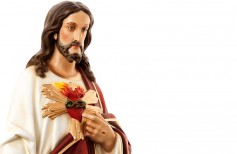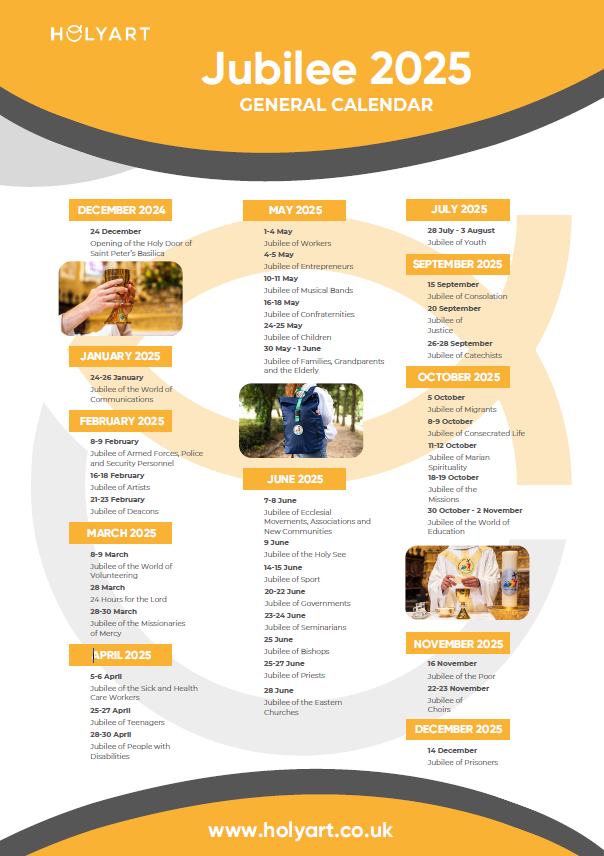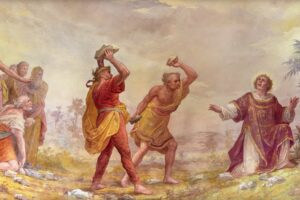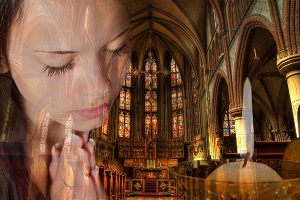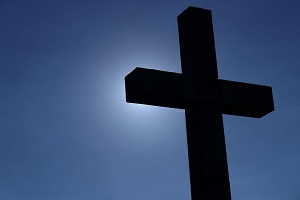On Good Friday, the Passion and death of Jesus are contemplated, in anticipation of the Easter miracle. Here are the most important moments of this solemn day.
Contents
Good Friday precedes Easter Sunday and marks the beginning of the end of Holy Week. On the afternoon of Good Friday, the Catholic Church commemorates the Passion of Jesus and His death on the cross. The choice to celebrate the Good Friday Liturgy in the afternoon originates from the Gospel tradition, according to which Jesus breathed His last at around 3:00 p.m.
As the second day of the Easter Triduum, the heart of the liturgical year, it is characterised by the absence of the Eucharistic celebration, fasting, and abstinence from meat. The date of Good Friday is movable and is not considered a public holiday.
Another important element in the Good Friday rites is silence. Just as the Holy Thursday celebration concludes with a moment of silence, so too does the Good Friday afternoon service begin in silence. It is during these days that the anticipation of Easter becomes more solemn, in an almost tangible suspension between sorrow and hope. Silence is observed out of respect, to make room for thoughts, meditations, and prayers. Even the bells remain still, mute, almost stunned in contemplation of the event unfolding in the memory of believers. The final, terrible days of Christ—from His arrest to His death, through the suffering of the Passion—are necessary stages of His greatest miracle, the fulfilment of His mission in the world.
We also recall why meat is not eaten on Good Friday, in respect of the rules of Lenten fasting, as stipulated by Canon 1251 of the Code of Canon Law. The rule of abstaining from meat strictly applies to Ash Wednesday, the Fridays of Lent, and particularly Good Friday.
Let us now look at the most significant moments of the Good Friday Liturgy, from the Readings and the homily to the Adoration of the Cross.

Via Dolorosa: the 14 bronze installations depicting the scenes of the Passion
It retraces the stages of the Passion of Jesus up to Calvary and it hosts a unique art installation
The Good Friday Liturgy
The heart of the Good Friday Liturgy is the so-called Liturgy of the Passion of the Lord, or In Passione Domini, an ancient rite of Byzantine origin dating back to the 7th century A.D. The Liturgy of the Passion is divided into three parts.
Liturgy of the Word
Readings are taken from Isaiah 52:13-53:12 (the Fourth Song of the Servant of the Lord, where the Servant referred to by the Prophet is identified with Christ); Hebrews 4:14-16; 5:7-9 (a meditation on the suffering and death of Jesus who, though the Son of God, allowed Himself to be killed for the salvation of all); and the Passion according to John (John 18:1-19:42).
At the end of the readings, the Universal Prayer is recited, composed of ten prayer intentions read by a deacon and interspersed with the priest’s prayers.
Adoration of the Holy Cross
The celebrant priest, the ministers, and the gathered faithful process before the Cross, kneeling before it and, in some cases, kissing it.
The Cross, covered by a veil, is brought to the high altar, flanked by two acolytes holding lit candles. The celebrant uncovers the left arm of the Cross and raises it, showing it to the faithful while proclaiming or singing the formula: “Ecce lignum Crucis.” The faithful respond: “Venite, adoremus.”
All adore the Cross in silence, remaining kneeling. The celebrant then uncovers the right arm of the Cross and raises it again, repeating the invitation. At the third elevation, the Cross is fully uncovered and placed where all may approach and venerate it.
In an alternative form, the priest approaches the church door to receive the uncovered Cross, which he carries in procession through the nave to the altar, followed by other ministers bearing lit candles. Along the way, he stops three times, and at each stop invites the faithful to adore.
During the procession before the Cross, the antiphon “We Adore Your Cross” is sung, along with other hymns and chants. At the end of the adoration, the Cross is returned to its place, and the candles and candlesticks are placed beneath it or on the altar.

Easter: 10 curiosities about the symbols of the Passion of Christ
Among relics and legends, ancient cults and modern devotions, here they are all
Holy Communion with the Pre-Sanctified
Although the Eucharistic celebration is not held on Good Friday, the faithful may receive Communion with the Pre-Sanctified. The Pre-Sanctified are Eucharistic species consecrated on the evening of Holy Thursday and distributed to the faithful in place of the Eucharist.
At the end of the service, no blessing is given. The celebrant and ministers, after genuflecting before the Cross, return to the sacristy in silence, without hymns or music.
Ambrosian Rite
The Good Friday celebration of the Passion of the Lord is slightly different in the Ambrosian Rite.
It is divided into two liturgical moments: the celebration of the Passion of the Lord in the afternoon, and the celebration of the Lord’s Deposition in the evening. The afternoon celebration begins with the announcement of the Lord’s Death, with the reading of the Passion according to Matthew (Matthew 27:1-56), and continues with the Adoration of the Cross and the Universal Prayer.
The evening celebration commemorates Christ’s deposition from the Cross, the preparation of His body by Joseph of Arimathea, and His burial, as described in Matthew 27:57-61.
Also, in the Ambrosian tradition, the Eucharist is not distributed on Good Friday or on any Friday during Lent.

The Way of the Cross
Another Good Friday tradition, usually held in the evening, is the Way of the Cross. The most important takes place in Rome at the Colosseum, where it was first celebrated in 1750 by Benedict XIV, Pope Lambertini, who dedicated the Colosseum to the Passion of Christ and the Martyrs and had the 14 stations and a large Cross erected.
Through various historical changes, the custom of the Way of the Cross at the Colosseum was maintained, abandoned, and later revived depending on the period. In 1965, it was reinstated by Paul VI and broadcast for the first time on RAI’s Eurovision. From 1977, the broadcast became worldwide and in colour. John Paul II wished that the meditations linked to the various stations be written not only by religious figures but also by laypeople.
Walking the Way of the Cross in silence and prayer is a way to feel closer to Christ, to follow His steps towards Calvary and death, a path traced by the Holy Spirit, which descends upon those who choose to follow the same journey.
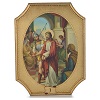
Here are the 14 Stations:
- Jesus is condemned to death
- Jesus takes up His cross
- Jesus falls the first time
- Jesus meets His mother
- Simon of Cyrene helps Jesus carry the cross
- Veronica wipes the face of Jesus
- Jesus falls the second time
- The women of Jerusalem weep for Jesus
- Jesus falls the third time
- Jesus is stripped of His garments
- Jesus is nailed to the cross
- Jesus dies on the cross
- Jesus is taken down from the cross
- Jesus is laid in the tomb





